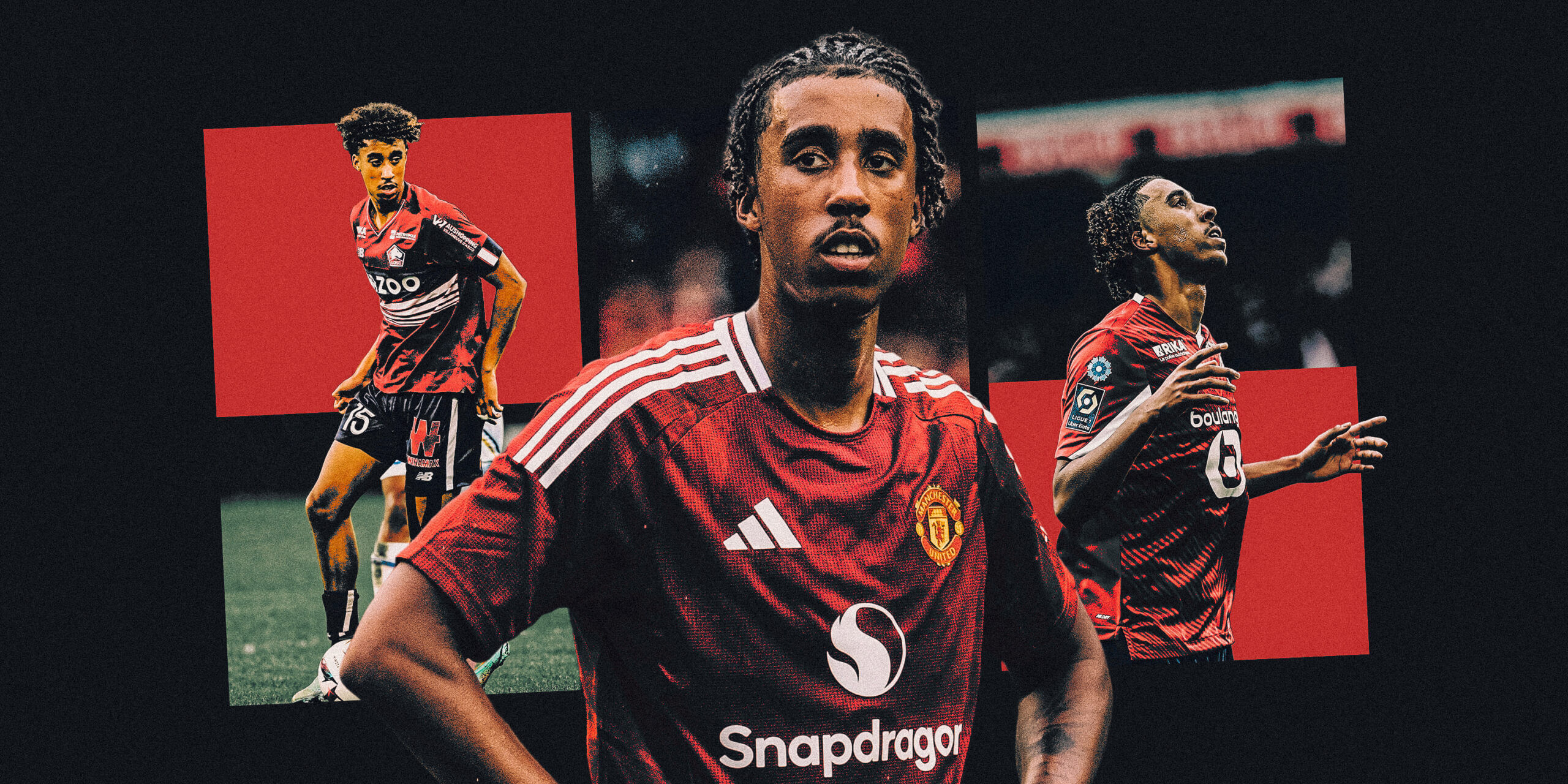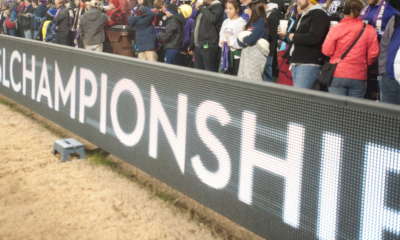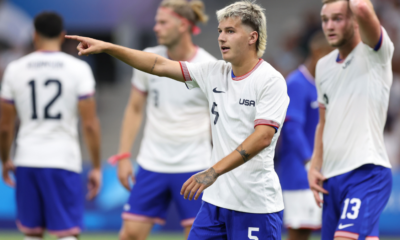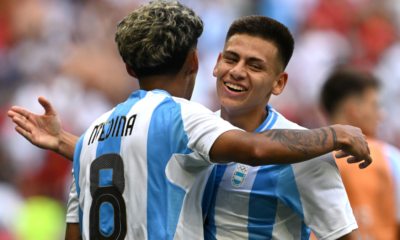Sports
Leny Yoro, from Paris boy to Man Utd: ‘He had the same speed as Kylian Mbappe’

There are always Sliding Doors moments in a player’s career; points when a lifetime’s path takes a critical turn, based on what feels like a coin toss.
In Leny Yoro’s case, it happened in the form of a red card.
On October 20, 2021, Baptiste Rolland’s dismissal for Lille Under-19s against their Sevilla counterparts in the UEFA Youth League transformed Yoro’s trajectory. Centre-back Rolland was dismissed in the 79th minute for pulling the shirt of Diego Rodriguez. Yoro, just 15 years old and previously a striker and then midfielder, came on to play in defence for the final few minutes, his first appearance for the French club’s under-19s side. The sending-off and Rolland’s subsequent suspension meant Yoro would start the team’s next Youth League fixture, the return at home against Sevilla.
It was the last time Olivier Szkwarok, who was in charge of Lille Under-16s at the time, would coach him.
“When Leny was an under-16, I said to the under-19 coach that he needs to play in the under-19s, but he didn’t have a place for him,” Szkwarok, now working as a youth coach at Toulouse, another French club, tells The Athletic. “But the first time he (started for the under-19s), he never returned with me. He was the best on the pitch.
“On that day, Liverpool and Monaco saw a lot of potential in him. After that, he was with the under-23s, and it was easy for him. Lille needed him to sign a professional contract and they invited him into the first team. Jocelyn Gourvennec, the first-team coach, loved his potential and said he could train with professionals full-time.
“I was a little surprised, but not surprised. Leny is a competitor and a hard worker.”
Yoro had joined Lille in 2017 from local side Villeneuve-d’Ascq. He initially grew up in Saint-Maurice, a suburb of Paris, 137 miles (222km) to the south, where he played his football in a playground opposite his home. Then he played for Alfortville, in the south-east of the French capital. His three brothers — Esteban (14), Eden (12) and Romeo (10) — all play football too; his father, Alain Yoro, had been in Lille’s academy himself as a teenager.
When Yoro was young, his parents split up and his mother, Flore Baugnies, moved the family to Bormes-les-Mimosas on France’s south coast for six months, before then going to Lille, in the north of the country near the border with Belgium, to be closer to family. That was when Yoro joined Villeneuve d’Ascq, known locally as VAM.
United’s Yoro battles with Rangers’ John Souttar last week (Ian MacNicol/Getty Images)
“The club is located in a working-class neighbourhood,” recalls Aboubacar Sankhare, the former Lens, Toulouse and Dusseldorf defender. “At the time Leny was there, I was the club’s general manager. He stayed at the club with his brothers for two-and-a-half to three years.
“From a very young age, he had this ability to adapt quickly, and he had this maturity. He understood instructions very quickly. He already had intrinsic qualities of his own. He played with the team of his age and a higher category (age group). He had his siblings, and his mother came to see them every day at the stadium. It was a social club.”
VAM fell into financial difficulties and no longer exist. At the time, though, Sankhare was leading the club’s social and educational projects, in addition to training youth sides with a view to some of those kids reaching the first team. In addition to Yoro and his brothers, Sankhare’s sons, Yssouf and Zakary, also joined professional clubs after playing at VAM.
Yoro stood out. But not in the position you would expect.
“He was a striker with us, and could play in all positions because he could adapt extremely quickly,” recalls Sankhare. “The Lille scouts came several times and reported on him. At the time, there were the biggest clubs in the region — Lens, Lille, Valenciennes, Dunkirk, Boulogne — who came to scout. He became a defender at Lille.”
When he went to Lille for a trial, Yoro impressed immediately. That was when Szkwarok, who coached the under-13s and then the under-16s at the club, first saw him play. “I loved him from the trial,” he recalls. “He was a different player. When he was 12, he was the same as now. For a tall player, he had good technique. But he was missing the speed. He had a good personality. Like today, he was a leader who always encouraged his team-mates.”
The years Szkwarok worked with Yoro bookmarked a critical period in his development. Yoro initially played in midfield, before switching positions. “He was a defender full-time from under-15,” says Szkwarok. “He had a very good technical level and a very good in-game intelligence. He can see and play quickly, with his left or right foot, and I think, at professional level, he can play in midfield if a coach needed him to. A little bit like John Stones at Manchester City. In my opinion, Leny has a better potential than John Stones.”
But not everything was straightforward.
“All of the coaches loved him for his personality but not all of them believed in him,” says Szkwarok. “In the under-14s, it was a little bit complicated. A coach said in a meeting that Leny does not have the potential to play at the highest level. For me, it was a big error to say that about Leny. Because he was a tall player, and we needed to give him a little bit of time to grow up, and after he can show his potential.”
Yoro had a growth spurt before the age of 16. Speaking to French newspaper La Voix du Nord, mum Flore recalled how “he gained 10 centimetres (almost four inches)” during his under-16 year but “all year long, he was injured”. “He injured himself, without taking any hits during matches,” she said. Yoro had to adapt to his changing body and Lille tailored their coaching to deal with his small, repetitive muscular issues.

Yoro going up against Kylian Mbappe in Ligue 1 last year (Franck Fife/AFP/Getty Images)
“Leny was always the tallest but he grew and it (led to) small injuries,” says Szkwarok. “He had them often. Two days (out of action), three days, four days. We found a solution and after we changed our method of training with him, he could train all day and played all the games.
“When he was an under-16, at the beginning of the season, we went to a small tournament. He hadn’t played during the season so in his first game, to protect him, I put Leny in midfield. Against (Belgium’s Club) Bruges and PSV (Eindhoven, from the Netherlands), he played very well. In defence you have to make more runs in behind, longer runs, and in midfield they are shorter.
“In order to adapt to his new body, he worked a lot. That’s why he’s always a good player technically and this part of his character is a very good example for his career in football.”
Yoro became one of the quickest and strongest in the group. But those years without exceptional pace had honed his ability to read the game too. It is a key trait, normally confined to experienced players, and it is something scouts picked up on when assessing him.

GO DEEPER
Leny Yoro to Manchester United: The Athletic 500 transfer ratings
“When he played against (France captain and now Real Madrid forward) Kylian Mbappe, he had the same speed as him,” says Szkwarok. “But when he was younger, Leny did not have a lot of speed and he developed the ability to read the game, both defensively and offensively. It is his best quality. A very intelligent player.
“He had the mentality of a defender. He loved defending, he loved intercepting the ball, winning the ball with his head. It is a little bit rare to have both qualities, to have technique and the mentality of a defender.”
Then came those under-19s matches against Sevilla in late 2021, under coach Stephane Pichot, and Yoro’s progress went up several gears. “It all started from there, because he played two more Youth League matches afterwards,” his mother said. “That’s where his No 15 comes from (which Yoro will now also wear at Manchester United). Because it all started when he was 15 years old.”
In October 2021, Yoro played with Lille Under-19s for the first time. By the following May, then aged 16, he had made his debut for their first team — coming off the bench away at Nice. In the process, he became the club’s youngest player since Joel Henry in 1978, surpassing Eden Hazard. He was invited to stay with the first team under new manager Paulo Fonseca in summer 2022 and, after just two days of pre-season training, the Portuguese coach had made up his mind.

Yoro holding back Aston Villa’s Ollie Watkins in the Europa Conference League last season (Justin Tallis/AFP/Getty Images)
“In all my years as a coach, I’ve never seen such a young player with so much maturity,” Fonseca told The Athletic last year. “He has so much class. So much elegance. He’s a beautiful player.” In the September, he became Lille’s youngest starter since Oumar Dieng in 1989.
“When we started to work with Leny, we saw a lot of potential,” Tiago Leal, Fonseca’s assistant, tells The Athletic. “We didn’t care about his age. We care about his skills. Technically, tactically, mentally, personality, character… he had many things that for his age were not normal.”
Taking the step into the professional game is never plain sailing, though. His full debut against Toulouse, a 2-1 Lille win, was a case in point. He won four of five aerial duels but also made an error that led to the Toulouse goal — a loose pass. He needed time, and the right environment, to adjust.
Under Fonseca, he would get that. Now in charge at AC Milan, Fonseca is no stranger to bringing through young talent, doing so with Diogo Jota (now of Liverpool and Portugal) at Pacos de Ferreira and then Mykhailo Mudryk (Chelsea and Ukraine) at Shakhtar Donetsk.
“In the first season, he made many mistakes that cost us many games, but for us, it was not a problem at all,” says Leal. “We knew it was part of the process with younger players. He was brave, because he never stopped trying to do what we demanded of him. We made a bet on him and as a team we were ready to pay the costs of this bet.”
Yoro’s first season of senior football was a learning curve. He made eight league starts and 15 appearances for Lille’s first team. How he responded to those inevitable rookie errors set him apart. “He’s really mature, his composure is not normal at his age,” says Leal. “That’s what impressed us. It wasn’t just because of his physical or technical qualities. It was the package. He was different from most of the others at his age.
“When he made mistakes, what I felt is that he was always stable, and that says a lot about his personality. He was always focused on his work, always trying to improve every day, not dependent on winning, losing, making a goal or not. He was always stable. That’s why he has this level of attention with Real Madrid, Paris Saint-Germain, clubs like that spotting him. Because it is special at his age.”
𝑻𝒉𝒆𝒏 & 𝒏𝒐𝒘 😍
Leny Yoro et nos diplômés 2023 ont reçu leur BAC lundi au Domaine de Luchin 🎓@leny_yoro ❤️ pic.twitter.com/ZjaMixgnX4
— LOSC (@losclive) April 24, 2024
Under Fonseca, Lille played an expansive brand of football, the coach demanding that his team press high up the field, take risks in possession and sometimes leave their defenders exposed with half a pitch of space in-behind. “Leny showed from the very beginning that he wanted to learn, to improve, and this is an important aspect of his character,” says Leal. “He is humble. When you have the skills technically, and when you are physically blessed — he’s really tall, fast, explosive — you need the desire to be better and courage to play the game we demand. He showed that from the beginning.”
His second season, 2023-24, bore fruit. Yoro started 30 league matches and featured in 44 games in all competitions. He succeeded the experienced Jose Fonte in Lille’s starting lineup, who had been a “role model” for him within the group according to Leal, along with the new captain Benjamin Andre. “He needed the mix of many things to help the flower grow,” says Leal. “We didn’t create the flower, we just gave it water, nutrients — the others and us are the gardeners.
“In the second season, he became the player we expected. He became more confident in himself, started to build this ego that you need, because he was ready to take his place in the team. He became almost complete. And we are speaking about a kid. I don’t have any doubts, about Leny. He’s getting what he deserves.”
His form earned him a place in the Ligue 1 team of the season, and elevated his status to one of the most exciting centre-backs in Europe. It was enough to persuade Manchester United to spend £52million ($65m; €62m), potentially rising to £59m, and fight off serious competition, making Yoro the most expensive player ever aged 18 or younger. (Mbappe was signed initially on a season’s loan by PSG before his €180m transfer from Monaco at age 19.)
Throughout his career, Yoro has quickly adapted to every challenge. United, English football and the Premier League will be a different order of magnitude but Leal feels he can thrive again.
“We cannot forget he is a young kid,” he says. “He is not going to solve every problem at Manchester United. Not alone. But if he gets a proper environment around him and the space and confidence to participate, I’m pretty sure he is going to be a main player for them.”

GO DEEPER
How Manchester United beat Real Madrid to the signing of Leny Yoro
(Top photos: Getty Images; design: Eamonn Dalton)













